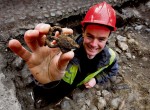While monks were living in monastic poverty in the deeply in debt Cistercian monastery of Duiske Abbey, their abbots lived the high life in a sweet little town house in 20 miles away in Kilkenny.
An Archaeological dig on the grounds of Rothe House, an early 17th c. merchant’s home, has turned up evidence of an earlier home inhabited by a succession of Duiske Abbey abbots. It was an elegant abode for the era, complete with a garderobe, a 14th c. toilet.
A garderobe was a small room built on to the outside wall of the upper floor of a medieval house. The toilet mechanism consisted of a hole in the ground surrounded by a wooden seat. Waste travelled down through a chute into a stone-built cess-pit in the garden.
Kitchen waste would also have been disposed of via the chute.
Among the finds made by the team were bones from swans and various choice cuts of beef; fragments of pottery wine jugs imported from Bordeaux; and “an intact stool” in which a fruit stone – possibly apricot – is embedded.
 They also found a belt buckle in amidst the rarified flesh and foul. Perhaps it fell in hole while the abbot was at trying to pass that apricot pit.
They also found a belt buckle in amidst the rarified flesh and foul. Perhaps it fell in hole while the abbot was at trying to pass that apricot pit.
While the abbot enjoyed the best the time had to offer, the monastery spent the centuries since its founding in 1204 scrounging for cash. Already by the end of the 13th c. speculation on the wool crop had left the monastery’s affairs deeply in debt to the Riccardi bankers of Lucca, money lenders to Edward I, aka the Longshanks of Braveheart fame. Lucky for the monastery, then, that the French crown confiscated the Riccardi bank’s assets when Edward went to war against France right at that time.
The days of swans and Bordeaux came to abrupt end when Henry VIII dissolved the monasteries and distributed their property to his supporters. Duiske Abbey was suppressed in 1536 and last abbot, Charles O’Cavanagh, was forced to resign. After that the monastery passed to the Earl of Ormond and the abbey church became the local parish church, which is remains to this day although most of the medieval structure is long gone.